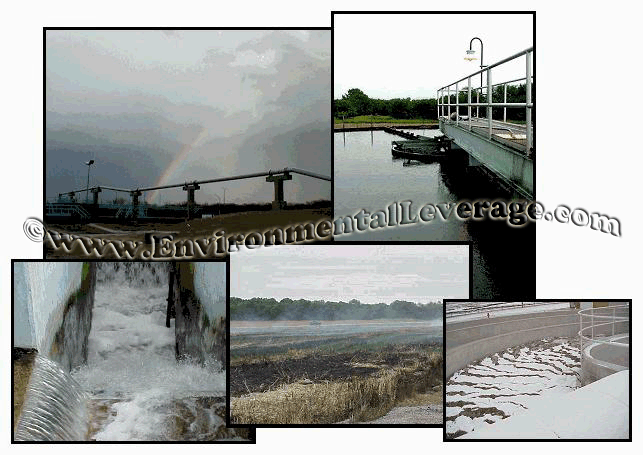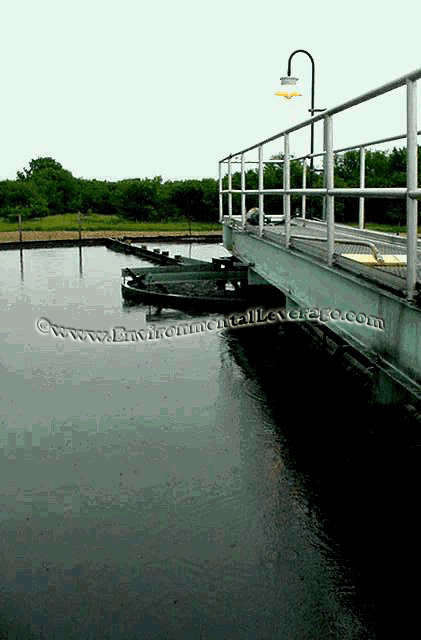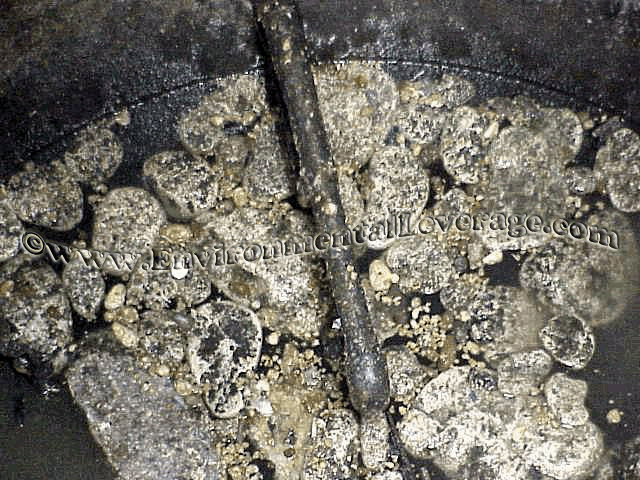Biological Products:
Bioaugmentation products for Wastewater applications in Papermills, Refineries, Chemical, Tanneries, Municipalities, Textiles, Steel, Agriculture, Animal feedlot, Gun Powder plant, Food and Beverage- Dairy Products, Orange Juice factory, Wineries, Cookie factory, Vegetable processing plant, Meat packing, Barbecue Restaurant, Aquaculture, Ornamental Ponds with algae , CAFO, Nursing homes, Military, Campgrounds, Universities, Regulatory agencies, River and Lake remediation
Lab Services:
Filamentous Identification Lab Service. One reason to identify filaments is to determine the filaments characteristics and then determine the type present. If the type is found out, a root cause can usually be associated with a particular filament. If the cause is known, then a correction can be made to alleviate problems. Chlorination is only a quick fix. Without process changes, filaments will grow back after chlorination. Wastewater Biomass Analyses and Cooling Tower Analyses also available
Training Materials:
Training is an integral part of any job. Not everyone is at the same level of training. Many people want beginning concepts and basics. Some need technical information or troubleshooting. Some want equipment, technology or process information. We have developed a full set of Basic training, Advanced training, Filamentous Identification the Easy Way as well as custom training CD's Manuals. We also provide hands-on training classes and soon will have an Online "E-University".
Audits and Consulting:
At Environmental Leverage® Inc., we have a team of experienced individuals who come into your plant with a fresh pair of eyes. The system is checked from influent to effluent. System optimization, equipment efficiency and operational excellence are key components explored. Key Benefits Equipment efficiency Total Cost of Operation reductions Reliability and safety An onsite audit is conducted to examine system parameters, process controls, and current monitor and control procedures. A physical walk-through is conducted, process flow diagrams are examined, previous design criteria are examined and current standard operating procedures are evaluated along with data logs.
|
Troubleshooting-Wild WeatherLatest News!
What's New!
We have just added "Virtual Audits" to our capabilities. Check out our new Services. We are in the process of developing new courses for our ""Online E-University" in order to meet the needs of our global customers that cannot travel to our public classes.Visit our new website www.WastewaterElearning.com/Elearning
How will wild and extreme weather impact your plant? What are some of the problems weather can cause?
What are some of the effects and some of the things you can do to combat these types of problems?
Obviously, most plants are designed with these issues considered. Many plants have spare EQ tanks, holding tanks, diversion ponds, heater or heat exchangers for just such occasions.
Some plants do not and are stuck running around trying to jury rig what ever they can to limp through the sudden weather changes that can impact their plant.
Excessive rain can cause hydraulic washout. This can impact many different parts of a plant.
Hydraulic
washout can cause problems in the primaries as well as the aeration basins.
Washing out too much of the MLSS
Rain also can cause huge chunks of grease to dislodge in sewer lines and lift stations to make its way down to the primaries of a wastewater treatment plant. Check your primaries, if you have the skimmers that need to be adjusted by hand, make sure you do it more often after high rains to pull out as much grease as possible. Definitely, make sure someone comes in on the weekend if you only normally run 5 days a week to pull the grease off the primaries. Many plants overlook this and build up too much grease on the weekends and come in to the plants on Mondays with many problems.
Both of these conditions can cause foaming in the aeration basin. Try to remove as much of the oil and grease in the primary as possible.
High rains, hurricanes or flooding can cause clarifiers to washout easier
than many of the other parts in the system. This can cause the beds to rise
Some plants have an EQ tank, a diversion tank, or empty aeration basins or clarifiers that they can divert some of the excess flow during high rains in order to bleed some of the water back into the system after the high rains have stopped. This is the best case scenario and allows the plant time to recover from the heavy rains, without causing any washout or loss of MLSS and efficiency of the plant. Some plants are not allowed this luxury.
Municipalities and some food plants that have to disinfect prior to discharge are significantly impacted by high rains and hydraulic overload. If the flows are too high and run too fast through the systems, especially if they have UV or ozone, they might have a hard time meeting permit levels. A typical 3-4 MGD plant can sometimes get as high as 10-15 MGD flow with very heavy rains! That is incredibly hard on a biological plant to handle.
Fires can cause additional problems, especially if inside the plant such
as an industrial site, or a fire in a city and the water Watch your system carefully after a fire, run more tests, check your nutrients if the incoming stream is higher in BOD. Look under the microscope at the bacteria, they will tell you what is going on long before it becomes critical.
Cold weather extremes can significantly impact a wastewater treatment plant. Did you know that for every 10° in temperature that the MLSS drops, the activity of the biomass changes one logs growth!!! Obviously, that means if the temperature drops below 70° or 60 F, you will have to increase your MLSS. If it gets really cold, you may need to carry a MLSS and have a higher bed in your clarifier 2-3 times what you do in the summer months
Oxidation ditches have many problems in the winter months due to the fact that they have a larger surface area. Also, they don’t have the benefits of some activated sludge plants that have Mechanical mixers that do generate some heat. Microthrix parvicella, a filamentous bacteria that can cause serious foaming problems loves cold weather, and many ditches seem to grow a significant amount of filaments in the winter. Watch all the variables at the plant and you can work around these issues.
Lagoons and once through system have a significant disadvantage also in the winter months. They cannot increase their RAS, so they are limited on their ability to degrade BOD. Remember that it is always a time and numbers game in a biological system. How much time you have is limited by the size of the equipment. You can only play with the numbers to adjust to changes in the incoming BOD values. Luckily, lagoons can use bioaugmentation during the winter months and still beat the game.
If you
Some plants consistently run from 115-120 ° F. These plants will get some BOD degradation, but will have poor floc formation, high TSS levels and have to watch their permits for TSS. Polymer consumption will probably increase also.
Contact Environmental Leverage Inc. if you need help with your plant on some of these issues!!
|

 Weather
is unpredictable. Extreme cold or high temperatures, excessive rain,
hurricanes, blizzards or drought can all impact the conditions of a
wastewater treatment plant.
Weather
is unpredictable. Extreme cold or high temperatures, excessive rain,
hurricanes, blizzards or drought can all impact the conditions of a
wastewater treatment plant.  from the aeration basin as well as the clarifiers can make your biomass
younger. While the carbonaceous bacteria can recover relatively quickly, the
from the aeration basin as well as the clarifiers can make your biomass
younger. While the carbonaceous bacteria can recover relatively quickly, the
 Heavy rains can cause numerous issues just in a lift station for
municipalities. Rain on the roads where construction occurs can wash off
high levels of oils that cars drip while stuck in traffic waiting for lanes
to change. This can cause foaming due to
Heavy rains can cause numerous issues just in a lift station for
municipalities. Rain on the roads where construction occurs can wash off
high levels of oils that cars drip while stuck in traffic waiting for lanes
to change. This can cause foaming due to 

 and float out over the edge of the clarifier, loosing a critical amount of
your MLSS.
and float out over the edge of the clarifier, loosing a critical amount of
your MLSS. 

 Droughts
or fires on the other hand can cause problems to the opposite extreme. Dry
weather for municipalities can tend to cause the flows to go lower, the MLSS
to get significantly older and filaments sometimes can dominate due to
longer MCRT and lower F/M ratios. When this happens, adjust your bed levels
in your clarifier, lower your MLSS according to your microscopic evaluation.
If you typically run at a medium age sludge and stalked ciliates and a few
rotifers are dominant, but suddenly you only have rotifers and many worms,
you know you are too old and need to increase wasting.
Droughts
or fires on the other hand can cause problems to the opposite extreme. Dry
weather for municipalities can tend to cause the flows to go lower, the MLSS
to get significantly older and filaments sometimes can dominate due to
longer MCRT and lower F/M ratios. When this happens, adjust your bed levels
in your clarifier, lower your MLSS according to your microscopic evaluation.
If you typically run at a medium age sludge and stalked ciliates and a few
rotifers are dominant, but suddenly you only have rotifers and many worms,
you know you are too old and need to increase wasting.

 Extremely
high temperatures can cause problems also. The higher the temperature,
oxygen transfer changes. Even though activity increases, DO levels seem to
drop off in the summer. Filaments and algae tend to increase in the summer.
Gassing and denitrification can increase also. Adjust your bed levels in
your clarifier, increase wasting if necessary. Some industrial facilities
even need to install heat exchangers, especially papermills.
Extremely
high temperatures can cause problems also. The higher the temperature,
oxygen transfer changes. Even though activity increases, DO levels seem to
drop off in the summer. Filaments and algae tend to increase in the summer.
Gassing and denitrification can increase also. Adjust your bed levels in
your clarifier, increase wasting if necessary. Some industrial facilities
even need to install heat exchangers, especially papermills.  start to climb over 100° F, you will still get BOD degradation, as long as
it is a steady temperature range. If your plant tends to jump around higher
and lower in temperature, your biomass may start to get temperamental. Any
time you make more than a 10% change, it is major to the bacteria. Try to
keep that in mind when making any adjustments.
start to climb over 100° F, you will still get BOD degradation, as long as
it is a steady temperature range. If your plant tends to jump around higher
and lower in temperature, your biomass may start to get temperamental. Any
time you make more than a 10% change, it is major to the bacteria. Try to
keep that in mind when making any adjustments. 
